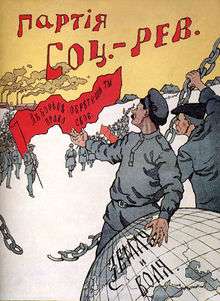Agrarian socialism
Agrarian socialism is a political ideology which combines an agrarian way of life with a socialist economic system.
Description
When compared to standard socialist systems which are generally urban/industrial and more progressive in terms of social orientation, many agrarian socialist movements have tended to be rural (with an emphasis on decentralization and non-state forms of collective ownership), locally focused and traditional.
The emphasis of agrarian socialists is therefore on social control, ownership and utilization of land, rather than other means of production, or by the national state.
A 17th-century movement called the Diggers based their ideas on agrarian communism.[1]
Russian populist tradition and the Socialist Revolutionary Party

The Socialist Revolutionary Party was a major political party in early 20th century Russia and a key player in the Russian Revolution. After the February Revolution of 1917 it shared power with other liberal and democratic socialist forces within the Russian Provisional Government.[2] In November 1917, it won a plurality of the national vote in Russia's first-ever democratic elections (to the Russian Constituent Assembly), but soon split and the remaining faction of this party which remained loyal to Alexander Kerensky was defeated and destroyed by the Bolsheviks in the course of the Russian Civil War and subsequent persecution.
The party's ideology was built upon the philosophical foundation of Russia's narodnik–Populist movement of the 1860s-70s and its worldview developed primarily by Alexander Herzen and Pyotr Lavrov.[3] After a period of decline and marginalization in the 1880s, the Populist/narodnik school of thought about social change in Russia was revived and substantially modified by a group of writers and activists known as "neonarodniki" (neo-Populists), particularly Viktor Chernov. Their main innovation was a renewed dialogue with Marxism and the integration of some of the key Marxist concepts into their thinking and practice. In this way, with the economic spurt and industrialization in Russia in the 1890s, they attempted to broaden their appeal in order to attract the rapidly growing urban workforce to their traditionally peasant-oriented program. The intention was to widen the concept of the "people" so that it encompassed all elements in the society that were opposed to the Tsarist regime.
The party's program was both democratic socialist and agrarian socialist in nature; it garnered much support among Russia's rural peasantry, who in particular supported their program of land-socialization as opposed to the Bolshevik program of land-nationalization—division of land among peasant tenants rather than collectivization in state management. Their policy platform differed from that of the Russian Social Democratic Labour Parties—both Bolshevik and Menshevik—in that it was not officially Marxist (though some of its ideologues considered themselves such); the SRs believed that the "laboring peasantry", as well as the industrial proletariat, would be the revolutionary class in Russia. Whereas Russian SDs defined class membership in terms of ownership of the means of production, Chernov and other SR theorists defined class membership in terms of extraction of surplus value from labor. On the first definition, small-holding subsistence farmers who do not employ wage labor are, as owners of their land, members of the petty bourgeoisie; on the second definition, they can be grouped with all who provide, rather than purchase, labor-power, and hence with the proletariat as part of the "laboring class". Chernov nevertheless considered the proletariat the "vanguard", with the peasantry forming the "main body" of the revolutionary army.[4]
See also
References
Footnotes
- Campbell 2009, pp. 127–129.
- Badcock, Sarah (2001). "'We're for the Muzhiks' Party!' Peasant Support for the Socialist Revolutionary Party during 1917". Europe-Asia Studies. 53 (1): 133–149. JSTOR 826242.
- Macfarlane, Leslie J. (1998), "From Russian Socialism to Soviet Communism", Socialism, Social Ownership and Social Justice, Palgrave Macmillan UK, pp. 142–174, doi:10.1007/978-1-349-26987-7_9, ISBN 9781349269891
- Hildermeier, M., Die Sozialrevolutionäre Partei Russlands. Cologne 1978.
Bibliography
- Campbell, Heather M (2009), The Britannica Guide to Political Science and Social Movements That Changed the Modern World, The Rosen Publishing Group, 2009, pp. 127–129, ISBN 978-1-61530-062-4
Further reading
| Wikiquote has quotations related to: Agrarian socialism |
- Bissett, Jim (2002), Agrarian Socialism in America: Marx, Jefferson, and Jesus in the Oklahoma Countryside, 1904-1920, University of Oklahoma Press
- Dejene, Alemneh (1987), Peasants, Agrarian Socialism, and Rural Development in Ethiopia, Westview Press
- Lipset, Seymour (1971), Agrarian Socialism: Cooperative Commonwealth Federation in Saskatchewan : A Study in Political Sociology, University of California Press
- Wilkison, Kyle G. (2008), Yeomen, Sharecroppers and Socialists: Plain Folk Protest in Texas, 1870-1914, Texas A&M University Press
